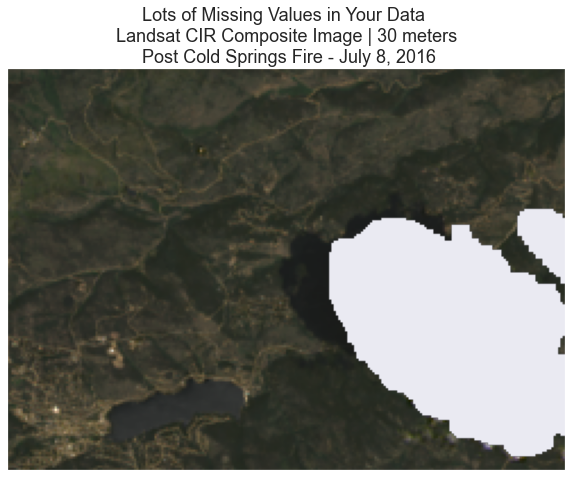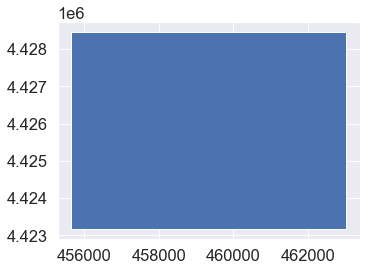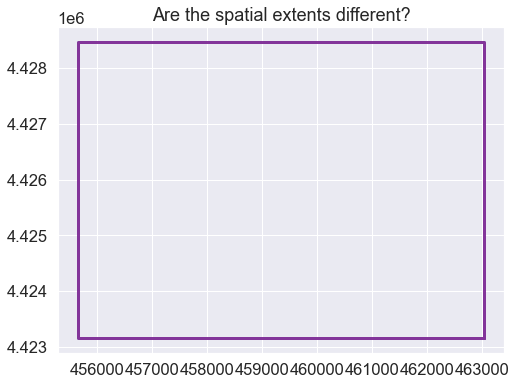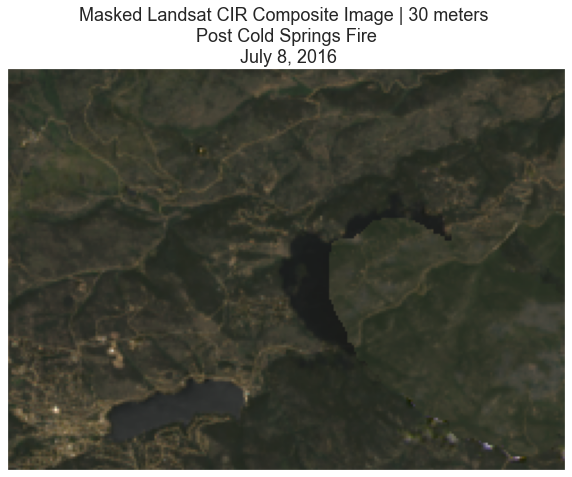Lesson 4. How to Replace Raster Cell Values with Values from A Different Raster Data Set in Python
Learning Objectives
- Replace (masked) values in one xarray DataArray with values in another array.
Sometimes you have many bad pixels in a landsat scene that you wish to replace or fill in with pixels from another scene. In this lesson you will learn how to replace pixels in one scene with those from another using Xarray.
To begin, open both of the pre-fire raster stacks. You got the cloud free data as a part of your homework, last week. The scene with the cloud is in the cold spring fire data that you downloaded last week.
import os
from glob import glob
import matplotlib.pyplot as plt
import seaborn as sns
from numpy import ma
from shapely.geometry import box
import xarray as xr
import rioxarray as rxr
import earthpy as et
import earthpy.spatial as es
import earthpy.plot as ep
import earthpy.mask as em
import pyproj
import geopandas as gpd
pyproj.set_use_global_context(True)
# Prettier plotting with seaborn
sns.set_style('white')
sns.set(font_scale=1.5)
# Download data and set working directory
data = et.data.get_data('cold-springs-fire')
data_2 = et.data.get_data('cs-test-landsat')
os.chdir(os.path.join(et.io.HOME, 'earth-analytics', 'data'))
Downloading from https://ndownloader.figshare.com/files/10960214?private_link=fbba903d00e1848b423e
Extracted output to /root/earth-analytics/data/cs-test-landsat/.
In the previous lesson, you learned how to open, clip and clean a set of Landsat .tif files. One of the challenges with these data were that there is a large cloud covering your study area.
In some analyses, when you have large clouds, it could make sense to
replace cloudy or shadow-covered pixels in a specific scene with pixels from another scene over the same area that are clear. You will learn how to replace pixels in this lesson.
To begin, import the Landsat tif files and mask out the clouds like you did in the previous lesson. You will use the same functions introduced in previous lessons to do this.
def open_clean_band(band_path, crop_layer=None):
"""A function that opens a Landsat band as an (rio)xarray object
Parameters
----------
band_path : list
A list of paths to the tif files that you wish to combine.
crop_layer : geopandas geodataframe
A geodataframe containing the clip extent of interest. NOTE: this will
fail if the clip extent is in a different CRS than the raster data.
Returns
-------
An single xarray object with the Landsat band data.
"""
if crop_layer is not None:
try:
clip_bound = crop_layer.geometry
cleaned_band = rxr.open_rasterio(band_path,
masked=True).rio.clip(clip_bound,
from_disk=True).squeeze()
except Exception as err:
print("Oops, I need a geodataframe object for this to work.")
print(err)
else:
cleaned_band = rxr.open_rasterio(band_path,
masked=True).squeeze()
return cleaned_band
def process_bands(paths, crop_layer=None, stack=False):
"""
Open, clean and crop a list of raster files using rioxarray.
Parameters
----------
paths : list
A list of paths to raster files that could be stacked (of the same
resolution, crs and spatial extent).
crop_layer : geodataframe
A geodataframe containing the crop geometry that you wish to crop your
data to.
stack : boolean
If True, return a stacked xarray object. If false will return a list
of xarray objects.
Returns
-------
Either a list of xarray objects or a stacked xarray object
"""
all_bands = []
for i, aband in enumerate(paths):
cleaned = open_clean_band(aband, crop_layer)
cleaned["band"] = i+1
all_bands.append(cleaned)
if stack:
print("I'm stacking your data now.")
return xr.concat(all_bands, dim="band")
else:
print("Returning a list of xarray objects.")
return all_bands
Open and process your data.
# Open pre fire Landsat data
landsat_dirpath_pre = os.path.join("cold-springs-fire",
"landsat_collect",
"LC080340322016070701T1-SC20180214145604",
"crop",
"*band[2-4]*.tif")
landsat_paths_pre = sorted(glob(landsat_dirpath_pre))
landsat_pre = process_bands(landsat_paths_pre, stack=True)
landsat_pre
I'm stacking your data now.
<xarray.DataArray (band: 3, y: 177, x: 246)>
array([[[ 443., 456., 446., ..., 213., 251., 293.],
[ 408., 420., 436., ..., 226., 272., 332.],
[ 356., 375., 373., ..., 261., 329., 383.],
...,
[ 407., 427., 428., ..., 306., 273., 216.],
[ 545., 552., 580., ..., 307., 315., 252.],
[ 350., 221., 233., ..., 320., 348., 315.]],
[[ 635., 641., 629., ..., 360., 397., 454.],
[ 601., 617., 620., ..., 380., 418., 509.],
[ 587., 600., 573., ..., 431., 513., 603.],
...,
[ 679., 742., 729., ..., 493., 482., 459.],
[ 816., 827., 824., ..., 461., 502., 485.],
[ 526., 388., 364., ..., 463., 501., 512.]],
[[ 625., 671., 651., ..., 265., 307., 340.],
[ 568., 620., 627., ..., 309., 354., 431.],
[ 513., 510., 515., ..., 362., 464., 565.],
...,
[ 725., 834., 864., ..., 485., 467., 457.],
[1031., 864., 844., ..., 438., 457., 429.],
[ 525., 432., 411., ..., 465., 472., 451.]]], dtype=float32)
Coordinates:
* band (band) int64 1 2 3
* x (x) float64 4.557e+05 4.557e+05 4.557e+05 ... 4.63e+05 4.63e+05
* y (y) float64 4.428e+06 4.428e+06 ... 4.423e+06 4.423e+06
spatial_ref int64 0
Attributes:
STATISTICS_MAXIMUM: 8481
STATISTICS_MEAN: 664.90340361031
STATISTICS_MINIMUM: -767
STATISTICS_STDDEV: 1197.873301452
scale_factor: 1.0
add_offset: 0.0- band: 3
- y: 177
- x: 246
- 443.0 456.0 446.0 475.0 487.0 498.0 ... 318.0 400.0 465.0 472.0 451.0
array([[[ 443., 456., 446., ..., 213., 251., 293.], [ 408., 420., 436., ..., 226., 272., 332.], [ 356., 375., 373., ..., 261., 329., 383.], ..., [ 407., 427., 428., ..., 306., 273., 216.], [ 545., 552., 580., ..., 307., 315., 252.], [ 350., 221., 233., ..., 320., 348., 315.]], [[ 635., 641., 629., ..., 360., 397., 454.], [ 601., 617., 620., ..., 380., 418., 509.], [ 587., 600., 573., ..., 431., 513., 603.], ..., [ 679., 742., 729., ..., 493., 482., 459.], [ 816., 827., 824., ..., 461., 502., 485.], [ 526., 388., 364., ..., 463., 501., 512.]], [[ 625., 671., 651., ..., 265., 307., 340.], [ 568., 620., 627., ..., 309., 354., 431.], [ 513., 510., 515., ..., 362., 464., 565.], ..., [ 725., 834., 864., ..., 485., 467., 457.], [1031., 864., 844., ..., 438., 457., 429.], [ 525., 432., 411., ..., 465., 472., 451.]]], dtype=float32) - band(band)int641 2 3
array([1, 2, 3])
- x(x)float644.557e+05 4.557e+05 ... 4.63e+05
array([455670., 455700., 455730., ..., 462960., 462990., 463020.])
- y(y)float644.428e+06 4.428e+06 ... 4.423e+06
array([4428450., 4428420., 4428390., 4428360., 4428330., 4428300., 4428270., 4428240., 4428210., 4428180., 4428150., 4428120., 4428090., 4428060., 4428030., 4428000., 4427970., 4427940., 4427910., 4427880., 4427850., 4427820., 4427790., 4427760., 4427730., 4427700., 4427670., 4427640., 4427610., 4427580., 4427550., 4427520., 4427490., 4427460., 4427430., 4427400., 4427370., 4427340., 4427310., 4427280., 4427250., 4427220., 4427190., 4427160., 4427130., 4427100., 4427070., 4427040., 4427010., 4426980., 4426950., 4426920., 4426890., 4426860., 4426830., 4426800., 4426770., 4426740., 4426710., 4426680., 4426650., 4426620., 4426590., 4426560., 4426530., 4426500., 4426470., 4426440., 4426410., 4426380., 4426350., 4426320., 4426290., 4426260., 4426230., 4426200., 4426170., 4426140., 4426110., 4426080., 4426050., 4426020., 4425990., 4425960., 4425930., 4425900., 4425870., 4425840., 4425810., 4425780., 4425750., 4425720., 4425690., 4425660., 4425630., 4425600., 4425570., 4425540., 4425510., 4425480., 4425450., 4425420., 4425390., 4425360., 4425330., 4425300., 4425270., 4425240., 4425210., 4425180., 4425150., 4425120., 4425090., 4425060., 4425030., 4425000., 4424970., 4424940., 4424910., 4424880., 4424850., 4424820., 4424790., 4424760., 4424730., 4424700., 4424670., 4424640., 4424610., 4424580., 4424550., 4424520., 4424490., 4424460., 4424430., 4424400., 4424370., 4424340., 4424310., 4424280., 4424250., 4424220., 4424190., 4424160., 4424130., 4424100., 4424070., 4424040., 4424010., 4423980., 4423950., 4423920., 4423890., 4423860., 4423830., 4423800., 4423770., 4423740., 4423710., 4423680., 4423650., 4423620., 4423590., 4423560., 4423530., 4423500., 4423470., 4423440., 4423410., 4423380., 4423350., 4423320., 4423290., 4423260., 4423230., 4423200., 4423170.]) - spatial_ref()int640
- crs_wkt :
- PROJCS["WGS 84 / UTM zone 13N",GEOGCS["WGS 84",DATUM["WGS_1984",SPHEROID["WGS 84",6378137,298.257223563,AUTHORITY["EPSG","7030"]],AUTHORITY["EPSG","6326"]],PRIMEM["Greenwich",0,AUTHORITY["EPSG","8901"]],UNIT["degree",0.0174532925199433,AUTHORITY["EPSG","9122"]],AUTHORITY["EPSG","4326"]],PROJECTION["Transverse_Mercator"],PARAMETER["latitude_of_origin",0],PARAMETER["central_meridian",-105],PARAMETER["scale_factor",0.9996],PARAMETER["false_easting",500000],PARAMETER["false_northing",0],UNIT["metre",1,AUTHORITY["EPSG","9001"]],AXIS["Easting",EAST],AXIS["Northing",NORTH],AUTHORITY["EPSG","32613"]]
- semi_major_axis :
- 6378137.0
- semi_minor_axis :
- 6356752.314245179
- inverse_flattening :
- 298.257223563
- reference_ellipsoid_name :
- WGS 84
- longitude_of_prime_meridian :
- 0.0
- prime_meridian_name :
- Greenwich
- geographic_crs_name :
- WGS 84
- horizontal_datum_name :
- World Geodetic System 1984
- projected_crs_name :
- WGS 84 / UTM zone 13N
- grid_mapping_name :
- transverse_mercator
- latitude_of_projection_origin :
- 0.0
- longitude_of_central_meridian :
- -105.0
- false_easting :
- 500000.0
- false_northing :
- 0.0
- scale_factor_at_central_meridian :
- 0.9996
- spatial_ref :
- PROJCS["WGS 84 / UTM zone 13N",GEOGCS["WGS 84",DATUM["WGS_1984",SPHEROID["WGS 84",6378137,298.257223563,AUTHORITY["EPSG","7030"]],AUTHORITY["EPSG","6326"]],PRIMEM["Greenwich",0,AUTHORITY["EPSG","8901"]],UNIT["degree",0.0174532925199433,AUTHORITY["EPSG","9122"]],AUTHORITY["EPSG","4326"]],PROJECTION["Transverse_Mercator"],PARAMETER["latitude_of_origin",0],PARAMETER["central_meridian",-105],PARAMETER["scale_factor",0.9996],PARAMETER["false_easting",500000],PARAMETER["false_northing",0],UNIT["metre",1,AUTHORITY["EPSG","9001"]],AXIS["Easting",EAST],AXIS["Northing",NORTH],AUTHORITY["EPSG","32613"]]
- GeoTransform :
- 455655.0 30.0 0.0 4428465.0 0.0 -30.0
array(0)
- STATISTICS_MAXIMUM :
- 8481
- STATISTICS_MEAN :
- 664.90340361031
- STATISTICS_MINIMUM :
- -767
- STATISTICS_STDDEV :
- 1197.873301452
- scale_factor :
- 1.0
- add_offset :
- 0.0
# Mask cloudy pixels
landsat_pre_cl_path = os.path.join("cold-springs-fire",
"landsat_collect",
"LC080340322016070701T1-SC20180214145604",
"crop",
"LC08_L1TP_034032_20160707_20170221_01_T1_pixel_qa_crop.tif")
landsat_qa = rxr.open_rasterio(landsat_pre_cl_path).squeeze()
high_cloud_confidence = em.pixel_flags["pixel_qa"]["L8"]["High Cloud Confidence"]
cloud = em.pixel_flags["pixel_qa"]["L8"]["Cloud"]
cloud_shadow = em.pixel_flags["pixel_qa"]["L8"]["Cloud Shadow"]
all_masked_values = cloud_shadow + cloud + high_cloud_confidence
# Mask the data using the pixel QA layer
landsat_pre_cl_masked = landsat_pre.where(~landsat_qa.isin(all_masked_values))
Plot the data to ensure that the cloud covered pixels are masked.
# Plot
ep.plot_rgb(landsat_pre_cl_masked,
rgb=[2, 1, 0],
title="Lots of Missing Values in Your Data \n Landsat CIR Composite Image | 30 meters \n Post Cold Springs Fire - July 8, 2016")
plt.show()

Read and Stack Cloud Free Data
Above you have a Landsat scene with a large block of cloud covered pixels (everything that is white represents clouds in that plot). To fill these pixels, you will replace the cloud covered pixels with pixels from a Landsat scene that covers the same area within a similar time period.
Next, read in and stack the cloud free landsat data. Below you access the bounds object of a rioxarray object with xarray_name.rio.bounds(). This contains the spatial extent of the cloud free raster. You will use this to ensure that the bounds of both datasets are the same before replacing pixel values.
Clip Your Cloud Free Landsat Scene to the Same Extent
Below you create a clip extent of your cloud covered seen to use to crop the cloud free scene. This crop step is important to ensure that pixels overlap and to further reduce memory needed to process your data.
# Create bounds object to clip the cloud free data
landsat_pre_cloud_ext_bds = landsat_pre.rio.bounds()
df = {'id': [1],
'geometry': box(*landsat_pre.rio.bounds())}
clip_gdf = gpd.GeoDataFrame(df, crs=landsat_pre.rio.crs)
clip_gdf.plot()
plt.show()

# Read in the "cloud free" landsat data that you downloaded as a part of your homework
cloud_free_path = os.path.join("cs-test-landsat",
"*band[2-4]*.tif")
landsat_paths_pre_cloud_free = sorted(glob(cloud_free_path))
landsat_pre_cloud_free = process_bands(landsat_paths_pre_cloud_free,
stack=True,
crop_layer=clip_gdf)
landsat_pre_cloud_free
I'm stacking your data now.
<xarray.DataArray (band: 3, y: 177, x: 246)>
array([[[590., 629., 636., ..., 218., 234., 283.],
[546., 580., 598., ..., 248., 270., 314.],
[484., 503., 506., ..., 284., 325., 348.],
...,
[434., 431., 438., ..., 290., 291., 303.],
[441., 490., 478., ..., 292., 312., 313.],
[340., 278., 297., ..., 299., 334., 337.]],
[[781., 808., 828., ..., 461., 485., 535.],
[748., 795., 807., ..., 491., 519., 574.],
[727., 754., 743., ..., 535., 590., 627.],
...,
[722., 724., 722., ..., 550., 554., 569.],
[706., 777., 756., ..., 546., 577., 591.],
[578., 484., 500., ..., 548., 590., 607.]],
[[770., 839., 845., ..., 331., 363., 412.],
[730., 793., 812., ..., 379., 421., 479.],
[657., 692., 691., ..., 441., 522., 573.],
...,
[697., 789., 797., ..., 497., 486., 505.],
[837., 788., 802., ..., 476., 505., 508.],
[542., 477., 465., ..., 510., 536., 536.]]])
Coordinates:
* x (x) float64 4.557e+05 4.557e+05 4.557e+05 ... 4.63e+05 4.63e+05
* y (y) float64 4.428e+06 4.428e+06 ... 4.423e+06 4.423e+06
* band (band) int64 1 2 3
spatial_ref int64 0
Attributes:
scale_factor: 1.0
add_offset: 0.0
long_name: band 2 surface reflectance- band: 3
- y: 177
- x: 246
- 590.0 629.0 636.0 650.0 659.0 656.0 ... 347.0 444.0 510.0 536.0 536.0
array([[[590., 629., 636., ..., 218., 234., 283.], [546., 580., 598., ..., 248., 270., 314.], [484., 503., 506., ..., 284., 325., 348.], ..., [434., 431., 438., ..., 290., 291., 303.], [441., 490., 478., ..., 292., 312., 313.], [340., 278., 297., ..., 299., 334., 337.]], [[781., 808., 828., ..., 461., 485., 535.], [748., 795., 807., ..., 491., 519., 574.], [727., 754., 743., ..., 535., 590., 627.], ..., [722., 724., 722., ..., 550., 554., 569.], [706., 777., 756., ..., 546., 577., 591.], [578., 484., 500., ..., 548., 590., 607.]], [[770., 839., 845., ..., 331., 363., 412.], [730., 793., 812., ..., 379., 421., 479.], [657., 692., 691., ..., 441., 522., 573.], ..., [697., 789., 797., ..., 497., 486., 505.], [837., 788., 802., ..., 476., 505., 508.], [542., 477., 465., ..., 510., 536., 536.]]]) - x(x)float644.557e+05 4.557e+05 ... 4.63e+05
- axis :
- X
- long_name :
- x coordinate of projection
- standard_name :
- projection_x_coordinate
- units :
- metre
array([455670., 455700., 455730., ..., 462960., 462990., 463020.])
- y(y)float644.428e+06 4.428e+06 ... 4.423e+06
- axis :
- Y
- long_name :
- y coordinate of projection
- standard_name :
- projection_y_coordinate
- units :
- metre
array([4428450., 4428420., 4428390., 4428360., 4428330., 4428300., 4428270., 4428240., 4428210., 4428180., 4428150., 4428120., 4428090., 4428060., 4428030., 4428000., 4427970., 4427940., 4427910., 4427880., 4427850., 4427820., 4427790., 4427760., 4427730., 4427700., 4427670., 4427640., 4427610., 4427580., 4427550., 4427520., 4427490., 4427460., 4427430., 4427400., 4427370., 4427340., 4427310., 4427280., 4427250., 4427220., 4427190., 4427160., 4427130., 4427100., 4427070., 4427040., 4427010., 4426980., 4426950., 4426920., 4426890., 4426860., 4426830., 4426800., 4426770., 4426740., 4426710., 4426680., 4426650., 4426620., 4426590., 4426560., 4426530., 4426500., 4426470., 4426440., 4426410., 4426380., 4426350., 4426320., 4426290., 4426260., 4426230., 4426200., 4426170., 4426140., 4426110., 4426080., 4426050., 4426020., 4425990., 4425960., 4425930., 4425900., 4425870., 4425840., 4425810., 4425780., 4425750., 4425720., 4425690., 4425660., 4425630., 4425600., 4425570., 4425540., 4425510., 4425480., 4425450., 4425420., 4425390., 4425360., 4425330., 4425300., 4425270., 4425240., 4425210., 4425180., 4425150., 4425120., 4425090., 4425060., 4425030., 4425000., 4424970., 4424940., 4424910., 4424880., 4424850., 4424820., 4424790., 4424760., 4424730., 4424700., 4424670., 4424640., 4424610., 4424580., 4424550., 4424520., 4424490., 4424460., 4424430., 4424400., 4424370., 4424340., 4424310., 4424280., 4424250., 4424220., 4424190., 4424160., 4424130., 4424100., 4424070., 4424040., 4424010., 4423980., 4423950., 4423920., 4423890., 4423860., 4423830., 4423800., 4423770., 4423740., 4423710., 4423680., 4423650., 4423620., 4423590., 4423560., 4423530., 4423500., 4423470., 4423440., 4423410., 4423380., 4423350., 4423320., 4423290., 4423260., 4423230., 4423200., 4423170.]) - band(band)int641 2 3
array([1, 2, 3])
- spatial_ref()int640
- crs_wkt :
- PROJCS["WGS 84 / UTM zone 13N",GEOGCS["WGS 84",DATUM["WGS_1984",SPHEROID["WGS 84",6378137,298.257223563,AUTHORITY["EPSG","7030"]],AUTHORITY["EPSG","6326"]],PRIMEM["Greenwich",0,AUTHORITY["EPSG","8901"]],UNIT["degree",0.0174532925199433,AUTHORITY["EPSG","9122"]],AUTHORITY["EPSG","4326"]],PROJECTION["Transverse_Mercator"],PARAMETER["latitude_of_origin",0],PARAMETER["central_meridian",-105],PARAMETER["scale_factor",0.9996],PARAMETER["false_easting",500000],PARAMETER["false_northing",0],UNIT["metre",1,AUTHORITY["EPSG","9001"]],AXIS["Easting",EAST],AXIS["Northing",NORTH],AUTHORITY["EPSG","32613"]]
- semi_major_axis :
- 6378137.0
- semi_minor_axis :
- 6356752.314245179
- inverse_flattening :
- 298.257223563
- reference_ellipsoid_name :
- WGS 84
- longitude_of_prime_meridian :
- 0.0
- prime_meridian_name :
- Greenwich
- geographic_crs_name :
- WGS 84
- horizontal_datum_name :
- World Geodetic System 1984
- projected_crs_name :
- WGS 84 / UTM zone 13N
- grid_mapping_name :
- transverse_mercator
- latitude_of_projection_origin :
- 0.0
- longitude_of_central_meridian :
- -105.0
- false_easting :
- 500000.0
- false_northing :
- 0.0
- scale_factor_at_central_meridian :
- 0.9996
- spatial_ref :
- PROJCS["WGS 84 / UTM zone 13N",GEOGCS["WGS 84",DATUM["WGS_1984",SPHEROID["WGS 84",6378137,298.257223563,AUTHORITY["EPSG","7030"]],AUTHORITY["EPSG","6326"]],PRIMEM["Greenwich",0,AUTHORITY["EPSG","8901"]],UNIT["degree",0.0174532925199433,AUTHORITY["EPSG","9122"]],AUTHORITY["EPSG","4326"]],PROJECTION["Transverse_Mercator"],PARAMETER["latitude_of_origin",0],PARAMETER["central_meridian",-105],PARAMETER["scale_factor",0.9996],PARAMETER["false_easting",500000],PARAMETER["false_northing",0],UNIT["metre",1,AUTHORITY["EPSG","9001"]],AXIS["Easting",EAST],AXIS["Northing",NORTH],AUTHORITY["EPSG","32613"]]
- GeoTransform :
- 455655.0 30.0 0.0 4428465.0 0.0 -30.0
array(0)
- scale_factor :
- 1.0
- add_offset :
- 0.0
- long_name :
- band 2 surface reflectance
Spatial Extent Check
In order to replace pixel values, you will need to ensure that the spatial extent or boundaries of each dataset are the same. Below you check the
bounds of each object.
# Are the bounds the same for both datasets?
landsat_no_clouds_bds = landsat_pre_cloud_free.rio.bounds()
landsat_pre_cloud_ext_bds = landsat_pre.rio.bounds()
print("The cloud free data bounds are:", landsat_no_clouds_bds)
print("The original cloud covered data bounds are:", landsat_pre_cl_masked.rio.bounds())
print("Are the bounds the same?", landsat_no_clouds_bds == landsat_pre_cloud_ext_bds)
The cloud free data bounds are: (455655.0, 4423155.0, 463035.0, 4428465.0)
The original cloud covered data bounds are: (455655.0, 4423155.0, 463035.0, 4428465.0)
Are the bounds the same? True
The bounds of each dataset are different. Thus you will want to clip each scene to ensure the data line up properly when you fill in the pixels of the cloud covered data.
Below you do two things:
- You create a box geometry using the extent of each layer. You will use this to crop your data.
- You then check again to ensure both layers overlap spatially,
# Create polygons from the bounds
cloud_free_scene_bds = box(*landsat_no_clouds_bds)
cloudy_scene_bds = box(*landsat_pre_cloud_ext_bds)
# Do the data overlap spatially?
cloud_free_scene_bds.intersects(cloudy_scene_bds)
True
Below you plot the boundaries. This is an optional step that simply shows you that the extent of the cloud covered data is much smaller compared to the cloud free scene. You will want to clip the cloud free scene to the extent of the cloud covered scene to make them align.
# Plot the boundaries
x, y = cloud_free_scene_bds.exterior.xy
x1, y1 = cloudy_scene_bds.exterior.xy
fig, ax = plt.subplots(1, 1, figsize=(8, 6))
ax.plot(x, y, color='#6699cc', alpha=0.7,
linewidth=3, solid_capstyle='round', zorder=2)
ax.plot(x1, y1, color='purple', alpha=0.7,
linewidth=3, solid_capstyle='round', zorder=2)
ax.set_title('Are the spatial extents different?')
plt.show()

# Is the CRS the same in each raster?
landsat_pre.rio.crs == landsat_pre_cloud_free.rio.crs
True
# Are the shapes the same?
landsat_pre.shape == landsat_pre_cloud_free.shape
True
You’ve now determined that
- the data have the same bounds
- the data are in the same Coordinate Reference System and
- the data do overlap (or intersect).
Because you clipped the data above, you don’t need to do any additional cleanup. However if your data did have different spatial extents or CRS’s you would have to do some more cleanup.
{'type': 'Polygon',
'coordinates': (((463035.0, 4423155.0),
(463035.0, 4428465.0),
(455655.0, 4428465.0),
(455655.0, 4423155.0),
(463035.0, 4423155.0)),)}
(3, 177, 246)
Replace Cell Values
You are now ready to replace values using xarray’s where() function.
# Get the mask layer from the pre_cloud data
mask = landsat_pre_cl_masked.isnull()
# Assign every cell in the new array that is masked
# to the value in the same cell location as the cloud free data
landsat_pre_clouds_filled = xr.where(mask, landsat_pre_cloud_free, landsat_pre_cl_masked)
landsat_pre_clouds_filled
<xarray.DataArray (band: 3, y: 177, x: 246)>
array([[[ 443., 456., 446., ..., 213., 251., 293.],
[ 408., 420., 436., ..., 226., 272., 332.],
[ 356., 375., 373., ..., 261., 329., 383.],
...,
[ 407., 427., 428., ..., 306., 273., 216.],
[ 545., 552., 580., ..., 307., 315., 252.],
[ 350., 221., 233., ..., 320., 348., 315.]],
[[ 635., 641., 629., ..., 360., 397., 454.],
[ 601., 617., 620., ..., 380., 418., 509.],
[ 587., 600., 573., ..., 431., 513., 603.],
...,
[ 679., 742., 729., ..., 493., 482., 459.],
[ 816., 827., 824., ..., 461., 502., 485.],
[ 526., 388., 364., ..., 463., 501., 512.]],
[[ 625., 671., 651., ..., 265., 307., 340.],
[ 568., 620., 627., ..., 309., 354., 431.],
[ 513., 510., 515., ..., 362., 464., 565.],
...,
[ 725., 834., 864., ..., 485., 467., 457.],
[1031., 864., 844., ..., 438., 457., 429.],
[ 525., 432., 411., ..., 465., 472., 451.]]])
Coordinates:
* band (band) int64 1 2 3
* x (x) float64 4.557e+05 4.557e+05 4.557e+05 ... 4.63e+05 4.63e+05
* y (y) float64 4.428e+06 4.428e+06 ... 4.423e+06 4.423e+06
spatial_ref int64 0- band: 3
- y: 177
- x: 246
- 443.0 456.0 446.0 475.0 487.0 498.0 ... 318.0 400.0 465.0 472.0 451.0
array([[[ 443., 456., 446., ..., 213., 251., 293.], [ 408., 420., 436., ..., 226., 272., 332.], [ 356., 375., 373., ..., 261., 329., 383.], ..., [ 407., 427., 428., ..., 306., 273., 216.], [ 545., 552., 580., ..., 307., 315., 252.], [ 350., 221., 233., ..., 320., 348., 315.]], [[ 635., 641., 629., ..., 360., 397., 454.], [ 601., 617., 620., ..., 380., 418., 509.], [ 587., 600., 573., ..., 431., 513., 603.], ..., [ 679., 742., 729., ..., 493., 482., 459.], [ 816., 827., 824., ..., 461., 502., 485.], [ 526., 388., 364., ..., 463., 501., 512.]], [[ 625., 671., 651., ..., 265., 307., 340.], [ 568., 620., 627., ..., 309., 354., 431.], [ 513., 510., 515., ..., 362., 464., 565.], ..., [ 725., 834., 864., ..., 485., 467., 457.], [1031., 864., 844., ..., 438., 457., 429.], [ 525., 432., 411., ..., 465., 472., 451.]]]) - band(band)int641 2 3
array([1, 2, 3])
- x(x)float644.557e+05 4.557e+05 ... 4.63e+05
array([455670., 455700., 455730., ..., 462960., 462990., 463020.])
- y(y)float644.428e+06 4.428e+06 ... 4.423e+06
array([4428450., 4428420., 4428390., 4428360., 4428330., 4428300., 4428270., 4428240., 4428210., 4428180., 4428150., 4428120., 4428090., 4428060., 4428030., 4428000., 4427970., 4427940., 4427910., 4427880., 4427850., 4427820., 4427790., 4427760., 4427730., 4427700., 4427670., 4427640., 4427610., 4427580., 4427550., 4427520., 4427490., 4427460., 4427430., 4427400., 4427370., 4427340., 4427310., 4427280., 4427250., 4427220., 4427190., 4427160., 4427130., 4427100., 4427070., 4427040., 4427010., 4426980., 4426950., 4426920., 4426890., 4426860., 4426830., 4426800., 4426770., 4426740., 4426710., 4426680., 4426650., 4426620., 4426590., 4426560., 4426530., 4426500., 4426470., 4426440., 4426410., 4426380., 4426350., 4426320., 4426290., 4426260., 4426230., 4426200., 4426170., 4426140., 4426110., 4426080., 4426050., 4426020., 4425990., 4425960., 4425930., 4425900., 4425870., 4425840., 4425810., 4425780., 4425750., 4425720., 4425690., 4425660., 4425630., 4425600., 4425570., 4425540., 4425510., 4425480., 4425450., 4425420., 4425390., 4425360., 4425330., 4425300., 4425270., 4425240., 4425210., 4425180., 4425150., 4425120., 4425090., 4425060., 4425030., 4425000., 4424970., 4424940., 4424910., 4424880., 4424850., 4424820., 4424790., 4424760., 4424730., 4424700., 4424670., 4424640., 4424610., 4424580., 4424550., 4424520., 4424490., 4424460., 4424430., 4424400., 4424370., 4424340., 4424310., 4424280., 4424250., 4424220., 4424190., 4424160., 4424130., 4424100., 4424070., 4424040., 4424010., 4423980., 4423950., 4423920., 4423890., 4423860., 4423830., 4423800., 4423770., 4423740., 4423710., 4423680., 4423650., 4423620., 4423590., 4423560., 4423530., 4423500., 4423470., 4423440., 4423410., 4423380., 4423350., 4423320., 4423290., 4423260., 4423230., 4423200., 4423170.]) - spatial_ref()int640
array(0)
Finally, plot the data. Does it look like it reassigned values correctly?
# Plot data
ep.plot_rgb(landsat_pre_clouds_filled.values,
rgb=[2, 1, 0],
title="Masked Landsat CIR Composite Image | 30 meters \n Post Cold Springs Fire \n July 8, 2016")
plt.show()

The above answer is not perfect! You can see that the boundaries of the masked area are still visible. Also there are dark shadowed pixels that were not replaced given the raster pixel_qa layer did not assign those as pixels to be masked. Thus you may need to do a significant amount of further analysis to get this image to where you’d like it to be. But you at least have a start at getting there!
In the case of this class, a large enough portion of the study area is covered by clouds that it makes more sense to find a new scene with cloud cover. However, it is good to understand how to replace pixel values in the case that you may need to do so for smaller areas in the future.
Share on
Twitter Facebook Google+ LinkedIn
Leave a Comment